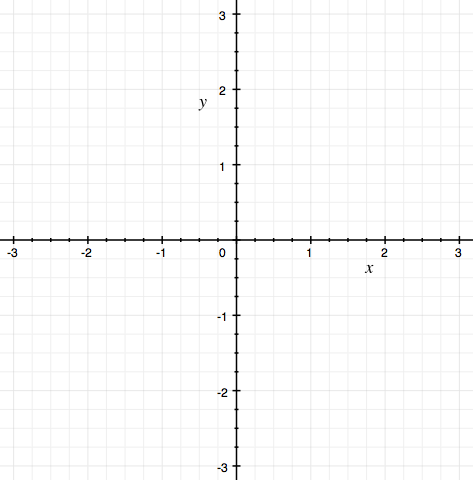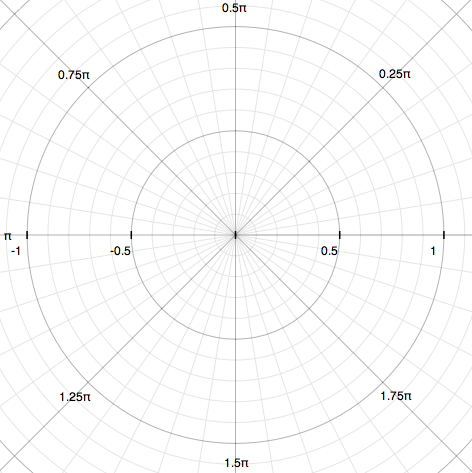Geometry: Coordinate Systems for Plane Curves
A coordinate system allows one to place points on a plane in a precise way. In other words, each point in the plane is given a precise manner of specifying their location. The most useful coordinate system is called rectangular coordinates system (also known as Cartesian coordinate system), and Polar Coordinate system.
Rectangular Coordinate System

In rectangular coordinates, two lines are used, called axes. One horizontal and one vertical. (The two axes are perpendicular to each other.) Their intersection is called the origin. The horizontal axis is called the x-axis, and the vertical one called the y-axis. Each axis is a number line. A number line is a line marked with numbers in regular intervals as in a ruler. On the x-axis, points to the right are positive, and to the left are negative. For the y-axis, points above the origin is positive, below are negative.
A pair of numbers, written in the form {c,d}, represents a point in the rectangular coordinate system.
Let there be a vertical line passing c on the x-axis, and let there be a horizontal line passing d on the y-axis. Their intersection is the point {c,d}.
In this way, every point in the plane can be specified uniquely by a pair of numbers {x,y}, and every pair of numbers represents a unique point in the plane.
Polar Coordinate System

In polar coordinate system, a point is specified by its angle to a ray and distance from the Pole.
In polar coordinate system, the plane is marked a point called Pole (sometimes also called Origin or Center). A horizontal ray is drawn from this point to the right, we call this the reference ray. A point in the plane is specified by two numbers {r,θ}. The θ is the angle from the reference ray. (positive angles have counter-clockwise sweep) The r is the distance from the point to the Pole. If r is negative, than the point is on the opposite side with respect to the Pole.
In this way, each pair of numbers {a,b} represents a point. In polar coordinate, a point can have many representations. For examples, {c,d} and {c,d + 2 Pi} are the same point. {c,d} and {-c, d+Pi} are the same point.
Usefulness
Polar coordinate is very useful when studying curves that has a center. For example, circle, Rose, Hypotrochoid, and spirals such as Equiangular Spiral.
For example, suppose we have a equation of two variables r and θ and we are told that this equation represents a curve in polar coordinates. Suppose the equation is r==3. Immediately, we can tell that it is a circle with radius 3. If the equation is r==θ, then we can tell that it is a spiral such that the distance from the pole to a point P on the spiral is equal to the sweep the spiral made. (This spiral is the Archimedes's Spiral )
We can also use a pair of functions f and g, written as {f[t],g[t]} to represent a curve using polar coordinates, where f[t] is distance from Pole to a point P on the curve at time t, and g[t] is angle of P at time t. A circle of radius 1 centered at pole would have a parametric formula of {1,t}. The Archimedes's spiral would be {t,t}.
Bipolar Coordinate System
The bipolar coordinate system works this way:
There are two given fixed points in the plane, usually labeled F1 and F2. These two points are called focuses. A point P in the plane, is specified by a pair of numbers {c,d}. The first number c, is the distance from P to F1, and the second number d, is the distance from P to F2.
Bipolar coordinates is useful for curves that has a bilateral symmetry and has two special focus points. For example, hyperbola , ellipse , cassinian oval , are such curves.
A equation of two variables f[x,y]==0 can be used to represent a curve in bipolar coordinate. Suppose {r1,r2} is a solution. Consider r1 as the distance from P to F1, and r2 the distance from P to F2. Thus we have point in the plane.
Parametric formula can also be used with bipolar coordinates. {f[t],g[t]} would mean that at time t, the point has a distance of f[t] to F1, and a distance of g[t] to F2.
Representing Curves with Coordinate Systems
The rectangular coordinate system, the polar coordinate system, and bipolar coordinate system, all represent a point by a pair of numbers {x,y}. This means, given a pair of numbers {c,d} that is said to represent a point in the plane, we must know what coordinate system is intended.
A equation of 2 variables f[x,y]==0, has a set of pairs of numbers {m,n} for which the equation is true. These set of pairs are called the solution of the equation. This solution set can be interpreted to be points with any coordinate system that represent points by a pair of numbers.
The method of representing a curve, by using a equation of 2 variables and interpreting the result on a rectangular coordinate system, is traditionally called a “implicit curve” or equation of the curve.
Alternatively, given a pair of functions of one variable {f[t],g[t]}, results a set of points for a range of values of t. This set of points can also be interpreted with any one of the coordinate systems that uses a pair of numbers to represent a point. This way of representing a curve, we call “parametric formula”.
(It is traditionally called “parametric equation”)
Curve By Equation
There are two ways to represent a curve in a rectangular coordinate system. One way is in the form of a equation f[x,y]==0, where for any pairs of number {x,y} the equation is true, is a point on the curve.
For example, a horizontal line passing {0,1} is y-1==0. An upward-opening parabola passing {0,0} is y-x^2==0. A circle centered on Origin with radius r is x^2+y^2-r^2==0.
The equation f[x,y]==0 can be interpreted to represent a curve in polar coordinate too, where, any solution {x,y} is interpreted to be a point on the curve using the polar coordinates. Usually, we use variables r and θ instead of x and y, if we want a polar coordinate interpretation. For example, f[r,θ]==0.
For example, a circle of radius 3 centered on the origin is r==3. The Archimedes's Spiral is r==θ. A vertical line passing {1,0} in polar coordinate would be Cos[θ] * r -1 ==0. A circle centered at {0.5,0} with radius 0.5 would be r==Cos[θ].
Curve By Parametric Formula
Another way is to specify a curve by what's called a “parametric formula”. That is, given two function f[t] and g[t], and for any given t we have a pairs of numbers {f[t],g[t]}, and this is taken to be a point on the curve. This is also often known as “parametric equation”.
(It is also known as “parametric equation” because it is often written as two equations x==f[t] and g==g[t].)
For example, a horizontal line passing {0,1} is {t,1}. An upward-opening parabola passing {0,0} is {t,t^2}. A circle centered on Origin with radius r is r * {Cos[t],Sin[t]}.
The parametric formula {f[t],g[t]} can also be used to specify a curve in polar coordinates. Here, f[t] would mean the distance from pole to a point on the curve P at time t, and g[t] would be the angle of P.
Intrinsic Systems of Curve Representation
Unit Speed Curve with Curvature Function
A curve can also be represented by a “Intrinsic System”. One way is by specifying the curve by a curvature function. For example, suppose you drive a car in a big field at constant speed. If we have a record of how you turn your steering wheel, then the path your car traveled is completely specified. In formula, we have a function f[t], where t is time and f[t] has length t, and f[t] is the Curvature of the curve at time t. So, in this way, a curve is specified as a function of its curvature. The curvature function is often denoted by the greek letter kappa: κ[t].
Specifying a curve by its curvature function is unique.
Unit Speed Curve by Tangent Angle
Other intrinsic system includes specifying curve by a function of its tangent inclination as a particle moves along the curve in unit speed. This is rarely used.
Equation form and Parametric form conversion
There is no algorithm to convert equation representation versus parametric representation. Mostly this activity is half a art, relying on ad hoc ingenuity in formula manipulation and knowledge of the curve's properties.
The art of converting a parametric formula to equation form, is called Elimination of Variables, a practice studied in a sub-branch of math in no longer taught Theory of equations. You are given two equations x==f[t] and y==g[t] (having 3 variables x, y, t), and you want to eliminate the variable t to arrive at a single equation of x and y that contains the same information. (That is: the set of {x,y} for the range of t given, is identical to the set of solutions in your newly derived equation of x,y.)
Given a t, both x and y are uniquely determined. But given x, there may be one or more t satisfying the equation set, and so there may be one ore more values of y. In general, eliminating t is impossible.
But in most curves mathematicians study, they often have special properties, that makes the equation form or the parametric form apparent, or not-difficult to convert.
Polar and Rectangular Coordinate conversion
There is no algorithm to convert formulas from different coordinate systems, or convert between equation and parametric forms. Mostly this activity is half a art, relying on ad hoc ingenuity. The following heuristics helps.
Given a function of two reals: f[a,b], this equation f[a,b]==0 can be considered as a curve in rectangular coordinate system, or it can also be considered as a curve in polar coordinate system. By convention, we write f[x,y]==0 for curves in rectangular coordinate system, and f[θ,r]==0 for curves in polar coordinate. So, given f[x,y]==0 we may want to derive g[θ,r]==0 for some g.
To convert between g[θ,r]==0 to or from f[x,y]==0, try to use these formulas:
r^2 == x^2+y^2
The above formula gives the distance of a point {x,y} to Origin, which is the polar coordinate's r.
θ == ArcTan[y/x]
The above formula gives the angle formed by the positive x-axes, {0,0}, and point {x,y}, which corresponds to polar coordinates's θ
For example, if given g[θ,r]==0, replace all occurrences of θ by ArcTan[y/x], then try to make all forms of r as r^2 by algebra, then replace all r^2 by x^2+y^2.
“Polar equation” of the form r==f[θ] to “parametric equation” conversion
Given a curve represented by a equation of the form r=f[θ] and interpreted in Polar coordinates, we want to find the parametric form {f[t],g[t]} with respect to the rectangular coordinate system.
Solution: If the equation has this form r=f[θ], then its parametric formula in rectangular coordinate system is: f[t]*{Cos[t],Sin[t]}
See also: Coordinate Transformation